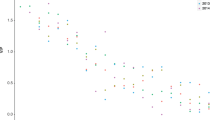Abstract
During the last 20–30 years the flagellate Gonyostomum semen has become more abundant in lakes, especially small humic lakes, in Scandinavia. Mass development of the alga has been reported from areas affected by anthropogenic acid deposition, and reports from bathers of health problems are becoming frequent. Although there is an apparent connection between the appearance of Gonyostomum and acidification, it seems not to be the low pH per se that is the cause, but rather interlinked factors. The present tendency towards a wider distribution of the alga in non-humic lakes, emphasizes the importance of a better understanding of small humic lakes.
Similar content being viewed by others
References
Bengtsson, B., 1985. Sännen - en referenssjö? Blekinges Natur. Årsbok 1985. pp. 45–58.
Björk S., 1967. Ecological investigations of Phragmites communis. Studies in theoretic and applied limnology. Folia limnol. stand. 14: 1–248.
Björndalen, K., 1982. Gonyostomum semen - En ny problemalge? Limnos. 2: 12–15.
Björndalen, K. & Ö. Lövstad, 1984. En regionalundersökelse av innsjöer i Östfold. Eutrofiering og problemealger. Vann 1: 123–132.
Bourrelly, P., 1970. Les algues d'eau douce. III. N. Boubée et Cie. Paris, pp. 512.
Brunsberg, K. & L. Lundahl, 1978. Blekingesjöar - försurningsstudie. Del 2: Å rtidsvariationer. Länsstryrelsen i Blekinge län, naturvårdsenheten, medd. 1978(1), pp. 121.
Buchanan, E. L., 1982. Planktonic photoheterotrophic and heterotrophic uptake of glucose in two acid lakes and one eutrophic lake in Northeastern Ohio. Kent State University Graduate College, USA. PhD thesis. (Mimeographed), pp. 143.
Cowles, R. P. & C. E. Brambel, 1936. A study of the experimental conditions in a bog pond with special reference to the diurnal vertical distribution of Gonyostomum semen. Biol. Bull. Mar. Biol. Lab., Woods Hole 71: 286–298.
Cronberg, G., 1982. Phytoplankton changes in Lake Trummen induced by restoration. Folia limnol. stand. 18: 1–119.
Dickson, W., 1978. Alkalinitet och pH i svenska vatten 1975–1978. Statens Naturv̇rdsverk. SNV PM 1106: 0–12.
Diesing, K. M., 1865. Revisionen der Prothelminthen. Abteilung Mastigophoren. Sitzungsber. d. K. K. Acad. Wiss. Wien 52: 287.
Drouet, F. & A. Cohen, 1935.The morphology of Gonyostomum semen from Woods Hole, Massachusetts. Biol. Bull. 68: 422–439.
Gerrath, J. F. & P. Denny, 1980. Freshwater algae of Sierra Leone III. Cyanophyta, Chrysophyta, Xanthophyta, Chloromonadophyta, Cryptophyta, Dinophyta. Nova Hedwigia 33: 933–947.
Gorham, E., S. E. Bayley & D. W. Shindler, 1984. Ecological effects on acid rain deposition upon peatlands: A neglected field in ‘Acid-Rain’ research. Can. J. Fish. aquat. Sci. 41: 1256–1268.
Heywood,P., 1973. Nutritional studies on the Chloromonadophyceae: Vacuolaria virescens and Gonyostomum semen. J. Phycol. 9: 156–159.
Heywood, P., 1980. Chloromonads. In E. Cox (ed.), Phytoflagellates. Elsevier North Holland, Inc.: 351–381.
Hongve, D., Ö. Lövstad & K. Björndalen. Gonyostomum semen - A new nuisance to bathers in Norwegian Lakes. Verh. int. Ver. Limnol. 23 (in press).
Ilmavirta, V., 1984. The ecology of flagellated phytoplankton in brown-water lakes. Verh. int. Ver. Limnol. 22: 817–821.
Levander, K. M., 1894. Materialien zur Kenntniss der Wasserfauna in der Umgebung von Helsingfors, mit besonderer Berücksichtigung des Meeresfauna. I Protozoa. Acta Soc. pro Fauna et Flora fennica 12: 31–34.
Lindmark, G. K., 1982.Acidified lakes: Sediment treatment with sodium carbonate - a remedy? Hydrobiologia 92: 537–547.
Lindmark, G. K., 1984.Acidified lakes: Ecosystem response following sediment treatment with sodium carbonate. Verh. int. Ver. Limnol. 22: 772–779.
Lindmark, G. K., 1985. Sodium carbonate injected into sediment of acidified lakes: A case study of Lilla Galtsjön treated in 1980. Proc. Int. Symposium on ‘Lake and Reservoir Management: Practical Applications’, North American Lake Management Society (NALMS), 16–19 Oct., 1984, McAfee, N.J. USA, pp. 89–93.
Manninen, P. & J. Kivinen, 1985. Gonyostomum semen (Ehr.) Dies. (Chloromonadophyceae) - Levän esiintymisestä ja veden laadusta eräillä vesistöalueilla. Tiedotus 266. Vattenstyrelsen, Helsingfors, pp. 44.
Nicholls, K. H. & P. J. Dillon, 1978. An evaluation of phosphorus-chlorophyll-phytoplankton relationship for lakes. Int. Revue ges. Hydrobiol. 63: 141–154.
Nygaard, G.,1977. Vertical and seasonal distribution of some motile freshwater algae in relation to some environmental factors. Algological Studies 18: 67–76.
Ripl, W. & G. K. Lindmark, 1979. The impact of algae and nutrient composition on sediment exchange dynamics. Arch. Hydrobiol. 86: 45–65.
Rosén, G., 1981. Tusen sjöar - växtplanktons miljökrav. Statens Naturvårdsverk. pp. 119.
Salonen, K., R. I. Jones & L. Arvola, 1984. Hypolimnetic phosphorus retrieval by diel migrations of phytoplankton. Freshwater Biology 14: 431–438.
SIS - Standardiseringkommissionen i Sverige, 1983. Determination of chlorophyll a in water - Extraction with methanol - Spectrophotometric method. Svensk Standard SS 02 8170, pp. 1–5.
Skuja, H., 1948. Taxonomie der Phytoplanktons einiger Seen in Uppland. Symb. Bot. Ups. 9, pp. 399.
Smith, V. H. & J. Shapiro, 1981. Chlorophyll-phosphorus relations in individual lakes. Their importance to lake restoration strategies. Envir. Sci. Technol. 15: 444–451.
Sommer, U. & Z. M. Gliwics,1986. Long range vertical migration of Volvox in tropical lake Cahora Bassa (Mozambique). Limnol. Oceanogr. 3: 650–653.
Sörensen, J., 1954. Gonyostomum semen (Ehrenb.) Diesing - en svensk vattenorganism av teoretiskt och praktiskt intresse. Svensk Faunistisk Revy 2: 1–5.
Van den Avyle, M. J., D. W. Allard, T. M. Dreier & W. J. Clark, 1982. Effects of diel phytoplankton migrations on chlorophyll a vertical profiles in a central Rxas pond. Texas J. Sci. 34: 69–78.
Author information
Authors and Affiliations
Rights and permissions
About this article
Cite this article
Cronberg, G., Lindmark, G. & Björk, S. Mass development of the flagellate Gonyostomum semen (Raphidophyta) in Swedish forest lakes - an effect of acidification?. Hydrobiologia 161, 217–236 (1988). https://doi.org/10.1007/BF00044113
Issue Date:
DOI: https://doi.org/10.1007/BF00044113




